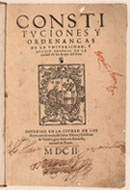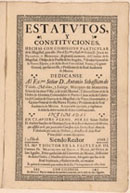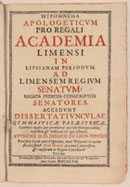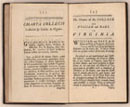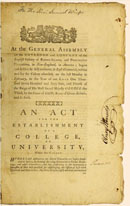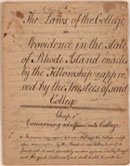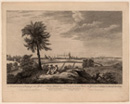|
||
Early modern Spanish kings were enthusiastic founders of universities: by 1790, Spain had twenty-three, or two per million inhabitants, among the highest number in Europe. The Spanish crown founded universities in the Americas early and often, typically granting a charter at the request of a city’s municipal or ecclesiastical authorities who sought the convenience and prestige of a local university. In addition, colleges associated with the religious orders often obtained the right to award academic degrees. England, by contrast, contained only two universities (though they were among the greatest in Europe): Oxford and Cambridge. Harvard and its companions were founded as colleges, though many were ultimately promoted to the status of university. At Oxford and Cambridge, the emphasis was on the liberal arts and theology, and much of the teaching was done by tutors in the colleges; in Spain, most of the teaching was done by endowed university professors, of whom the most prestigious were those of law and theology. |
||
The first universities The first American universities were founded in 1551 in Lima and Mexico City, the capitals of Castile’s two American Viceroyalties, Peru and New Spain. (There was an even earlier attempt in Santo Domingo, but it did not bear fruit until much later.) Lima’s charter is dated a few months before Mexico’s, so the University of Lima, known as San Marcos, has always claimed precedence. But the Mexican university opened its doors quickly, while Lima’s was delayed for twenty years by political turmoil and lack of funds. After the 1570s, though, it expanded rapidly. Among its endowed chairs was that of Quechua, whose professor took responsibility for testing the language skills of priests preparing to preach in Indian parishes. |
 |
|
Saints in Lima This map of Lima shows the university close to the center of the city, adjoining the headquarters of the Inquisition. Of the sixty-one locations marked on the map, the great majority are religious establishments – churches, convents, hospitals – as well as colleges, most of them affiliated with one of the religious orders. Around the sides are portraits of Santa Rosa de Lima, San Francisco Solano and San Toribio Alfonso de Mogrovejo, the saints whom seventeenth-century Peru claimed as its own. The map situates the University of Lima in a highly ecclesiastical context, in a city encircled by strong walls: the Church Militant. |
||
Juan Palafox de Mendoza Courses at the Royal and Pontifical University of Mexico began in 1553, two years after its charter was granted. As it grew and evolved, the crown occasionally ordered inspectors to study and revise the University's constitutions. Juan Palafox de Mendoza, bishop of Puebla, General Inspector, and, briefly, viceroy of Mexico, was a vigorous reformer, frequently at odds with other royal officials. This collection of university statutes reflects his thorough-going reforms, ordered in 1639 and completed in 1646. |
||
Educational institutions in Mexico City |
||
Decade VII: Important for Universities This chronological table lists, in Decade VII, the foundations of the Universities of Lima, Mexico, and Santo Domingo. Also issued in book form, these tables were reprinted on many occasions in various cities throughout Spain, attesting to their popularity. |
||
“Shall I go to the New World?” In 1605 the Flemish philosopher Justus Lipsius, writing about the institutions of higher learning in ancient and modern Europe, Africa and Asia, concluded: “And what else? Shall I go to the New World? There, indeed, there is nothing but barbarism.” Infuriated, the Lima professor of canon law Diego León Pinelo wrote a passionate defense of his own university in ornate and erudite Latin. The book became a favorite among Lima’s intellectual class for decades to come. |
 |
|
Rivalry in Bogotá In the major Spanish American cities, institutions of higher education proliferated. Seventeenth-century Bogotá saw a bitter rivalry between the Dominican-controlled Universidad Santo Tomás and the Jesuits’ Academia Javeriana (today the Pontificia Universidad Javeriana). The solution of Archbishop Cristóbal de Torres (pictured here) was to found a third school, the Colegio Mayor de Nuestra Señora del Rosario (1653), which outclassed both of its competitors in prestige. |
||
Fund-raising for Harvard In 1636 the General Court, the legislature of Massachusetts Bay Colony, founded what was to become Harvard College with the explicit goal of training Puritan ministers. But Harvard was not simply a divinity school, any more than the universities of Spanish America. As Lima and Mexico took their model from Salamanca, Massachusetts followed the colleges at Cambridge University. Its focus was the arts curriculum: the same course of great books being read in the universities of the Catholic world. Its teaching, though, was more informal, in keeping with the collegiate tradition in which most teaching was done by advanced students, in the role of tutors, while the capstone classes, especially the most prestigious, moral philosophy, were taught by the president. New Englands first fruits was published in England as a fund-raising effort for the newly founded college. |
||
George Washington, LL.D. A century and a half after its founding, Harvard was still a small institution, but it had finally attained the status of a university. Not long before, Harvard had awarded an honorary degree to General – now President – George Washington. |
||
Raising money from pirates In contrast to the rapid pace of early foundations in the Spanish colonies, Harvard was the only English colonial college for half a century. In 1691 the Virginia House of Burgesses sent an Anglican minister, James Blair, to London to obtain a charter from the King and Queen after whom the college was to be named. He also needed to raise money. He did this by negotiating amnesty for a group of pirates recently sent by Virginia to England for trial, in exchange for 300 pounds. Like Lima, Mexico City, and Harvard, the College remained a public institution throughout the colonial period. But it was unique in the British colonies in having the right to send a representative of the College to sit in the House of Burgesses. |
||
“It comes! at last” William Smith, a liberal Anglican clergyman from Scotland, here described the College of Mirania, a “purely fictitious institution,” as a model of what a college in the American colonies should look like. Beginning with a hymn to sing at Convocation, “It comes! at last, the promis’d AERA comes,” Smith outlined a modern and nonsectarian curriculum, combining the traditional liberal arts with agriculture, history, and politics. Benjamin Franklin came across the book and invited its author to Philadelphia. Smith became provost of the recently created Academy of Philadelphia and oversaw its expansion into the College of Philadelphia – what would eventually become the University of Pennsylvania. |
||
Birth of Brown |
 |
|
Copying out the laws of the College Rather self-referentially, Rule 3 of Brown’s College Rules stated: “No student shall be admitted to this College until he shall have written out a correct copy of the Laws of the College, or have otherwise obtained them, and had them signed by the President & one, or more, of the Tutors, as the Evidence of his admission, which copy he shall keep by him during his residence in College.” This copy is in the hand of Nicholas Brown, Jr., son and nephew of three of the College of Rhode Island’s founders, and its future benefactor. It was in recognition of his gifts that the college changed its name to Brown University in 1804. |
||
The College Ediface The College of Rhode Island’s first building, known as the College Ediface (now University Hall), was the largest building in Rhode Island when it was constructed in 1770. It was dormitory, recitation hall, and chapel for the entire college, which had 60 students in 1790. The only significant facility not located in the Ediface itself was the privy, part of which is visible at the far right in the engraving. |
||
No encomium on learning Twenty-six years after the founding of the College of New Jersey (the future Princeton University), its president wrote this appeal to Caribbean planters to donate to the college. A constant search for funds, from private and public sources, was typical of the newly founded colleges and universities throughout the Americas. The College of New Jersey, founded by New Light Presbyterians to train an evangelical ministry in the wake of the Great Awakening, here looked to the wealthy slaveowners of Jamaica and Barbados for donations. Beginning, “Gentlemen, It is unnecessary to begin this Address by a laboured encomium on Learning in general,” Witherspoon went on to provide the legally appropriate language for bequeathing both real estate and chattel property to the College. |
||
14. William Tennant and Henry Dawkins, “A North-West prospect of Nassau-Hall, with a front view of the Presidents House, in New-Jersey.” In: Samuel Blair, An account of the College of New-Jersey (Woodbridge, 1764). |
||
The Future Columbia University In this bucolic engraving, the city of New York appears small from the perspective of its larger rural environs. But within the city the newly built College of New York (also known as King’s College, the future Columbia University, founded 1754), with its high cupola and six chimneys, dominates the picture. Then located near the southern tip of Manhattan, it is the largest building visible; Trinity Church, which had donated land to the college, is visible just behind it. In the foreground (near modern Tribeca) the London engraver has added an incongruous palm tree. |
||
College in Philadelphia A plan of Philadelphia showing the location of the college on Fourth Street. |
||
| To next section, In Deo Speramus. | ||
To read the entire scanned book, go to the John Carter Brown Library's Internet Archive book at this link. |
||
| the Exhibition may be seen in the reading room from April 2014 through october 2014. |








